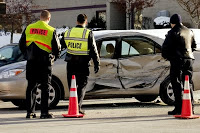Category Archive: Safe Driving

Earphones, Earbuds and Headphones While Driving
August 18, 2010
Since the invention of cars, drivers have had some sort of device to play music even if it was portable. Many years ago, when you drove your car, you only had the radio to listen to. The radio was proven to be a distraction even then. As technology progressed in vehicles, drivers had the option of having 8 tracks, cassette and then CD players installed in their cars. With today’s technology, tapes and CDs are an item for the history books. Now the major media devices are MP3 players and iPod’s. These small music players have the ability to hold someone’s entire music collection in a small “razor thin” electronic device. Now people can listen to their music on the go…anytime, anywhere, which has posed some problems.
In the last few years, manufactures have been installing inputs in vehicles that allow people to hook up their MP3 or iPod players. If you are not able to have a new car with an MP3 player connection it can be difficult to listen to your music. Lacking the proper connection, some drivers have turned to listening to their MP3 and iPod players through their earphones while driving their vehicles.
While driving any vehicle, using earphones presents many risks and is illegal in most states.
The most obvious reason this is dangerous is that you cannot hear what is happening around you. With headphones on, it becomes very hard to hear emergency vehicles, and other cars that might honk to alert you of a pedestrian, another vehicle or potential hazards. In addition, wearing headphones prevents you from hearing your own vehicle which may be making noises indicating a mechanical problem.
A final problem with using your MP3 player in your car is the potential distraction, even without the earphones on. Many iPod’s and MP3 players have enough storage space for your whole music collection. With a great amount of songs to select from, driver’s can be distracted scrolling through songs and picking the “perfect” driving playlist.
Not only is it illegal to wear headphones while driving a vehicle, but it is also illegal to wear them while riding a bicycle. Remember most states apply their driving laws to cyclists, which includes proper use of hand signals, lane obedience, etc. Many times a vehicle is not able to see bike traffic, so it is even more important cyclists hear cars and trucks.
If you do have an iPod or MP3 player and find it impossible to drive without your music, there are a few things you can do to make your drive a bit safer:
- If your vehicle does not have a MP3 or iPod hook up consider buying a FM transmitter or a cassette tape adapter. Both of these devices will enable you to play your music player through your stereo.
- In order to avoid becoming distracted while driving make up some playlists of your favorite songs, this way you will not be scrolling through your music collection trying to pick out songs you like.
- If you find that you have dropped or need to adjust your music player, find a safe place pull into. If you must pull of the road, pull all the away off and give yourself three feet of extra space margin away from the roadway. This will provide extra protection from a distracted driver who may drift into your lane and with give you a better view when you are ready to get back on the road.
By following these tips you can reduce your distractions and enjoy driving while listening to your favorite music.
Dori Slosberg Foundation Programs That are Saving Lives on our Highways
July 15, 2010
The Dori Slosberg Foundation is a private non-profit public service organization dedicated to traffic safety. It is named after the daughter of State Representative Irv Slosberg, Dori Slosberg, who at 14 was killed, along with four others in a car crash while their seat belts were unbuckled.
The foundation’s mission is to further educate the public about the importance of traffic safety while promoting safe driving habits and helping Florida law enforcement to ensure a risk-free driving environment on roadways. They also support nationwide programs that enable law makers to save lives through legislation. An example of this is the development of the Dori Slosberg and Katie Marchetti Safety Belt Law, which increases the effectiveness of safety belt law enforcement.
Since it was established in 2004, the Dori Slosberg Foundation has developed with several programs and initiatives to provide information on traffic safety including:
Staying Alive on 95, 75 & Florida’s Roadways
Focused on keeping Interstate 95, Interstate 75 and Florida’s roadways as safe for driving as possible, this program brings together concerned individuals and law enforcement to work on innovative ways to keep Florida’s major roadways safer.
DUI 0 Tolerance
This annual brings DUI law enforcement and relatives of DUI victims together, providing an outlet to tell their stories of loss, and reiterating a no-tolerance policy for DUI offenders.
Driver’s Education & Safe Teen Driving Programs
The foundation has set out to form assemblies across the state of Florida which reinforces the value that driving safety begins with proper driver education, before teens even obtain their licenses. They hold conferences for teachers and instructors to create awareness of current resources and technology available for them and to ensure students are getting the quality driver education they deserve. They also reinforce the idea that, before teens get their licenses, they should know about seat belt safety and the dangers of distracted driving.
Safe Senior Transportation
The foundation has been working to find ways to give alternative means of safe transportation for those who are unable to drive due to age or disability. They also provide a one-stop shop for getting elder drivers license renewal and assessment of their driving skills. They also hold a forum for giving safety tips for senior drivers.
Through committed passion and constant attention, these programs and the support of the public have turned the Dori Slosberg Foundation into an influential force when it comes to traffic safety.

Teen Driver Safety – When the Crash Isn’t Avoided
June 23, 2010
More often than not, teenagers are taught how to avoid vehicle crashes as opposed to correct procedures if they are ever a crash. Obviously, new drivers are taught defensive driving techniques to ensure their safety on the roadways and to minimize their risks. However, odds are that most teenagers will be involved in at least a minor crash.
The period of time between Memorial Day Weekend and Labor Day is when the most teenagers are involved in vehicular crashes. Below, you will find a basic checklist of things you should go over with your teenager to provide a better understanding of what to do after as well as the insurance aftermath from the crash.
- Discuss insurance basics: If you haven’t already explained to your teenager how insurance rates and premiums work, this is probably a good place to start. Explain why it costs much more to insure an experienced driver and explain the savings associated with a good driving record.
- Consider a contract: A teen driving contract would outline what is expected of the teenager (i.e. safe driving practices, curfews, etc). It would also outline who would cover the rise in insurance costs following a crash and any other consequences your teenager would face as a result of failing to live up the expectations you outlined.
- Insurance and Registration should be in the glove box: Make sure your teenager knows to have the insurance card and registration in a place that is easily accessible and won’t get lost. The glove box is the ideal place.
- Some additional things to consider keeping on hand: A small first-aid kit, self-lighting emergency flares, a disposable camera, a small notebook and a pen to take down another driver’s contact information, and lastly, names/numbers for rescue personnel to contact.
- Document the Crash: Photograph the incident, even if there is minimal damage. If you don’t have a disposable camera in your car the camera on your phone will suffice. If there were any witnesses make sure to get their names and numbers. Witnesses can help you sort out details later.
- File a police report: it is best to file a police report and have it recorded. This is the choice of both drivers to determine even if it was just a fender bender.
- Don’t place blame: Getting involved in a game of finger pointing with another driver is never a good idea. Instruct your teenager to wait in the vehicle until the police arrive if the other driver is trying to confrontational. No good can come from getting in a fight with the other driver.
Even if you think you were at fault, you may not be. That’s why insurance agents recommend that you not accept fault or blame at the scene. It is best to let the police officer sort it out.

Graduated Drivers License Laws Around the United States
June 3, 2010
Young drivers in the United Stares are subject to many different laws, regulations and procedures. Many of the rules, regulations, privileges and limitations are similar from state to state but some also differ greatly. It would be overwhelming to compare the rules and regulations young drivers face in all 50 states. It’s easier to compare the policies of a handful of states. Many states differ on age young drivers can obtain their learner’s permits and driver’s licenses; they also differ on nighttime driving and passenger restrictions. Additionally the amount of supervised driving various from state to state and the length of time a young driver needs to have a learner’s permit before they can obtain a driver’s license various as well.
Minimum Age to Obtain a Leaner’s Permit
Many states allow teenagers to get their learner’s permits once they have turned 15. The minimum age to obtain a learner’s permit in Florida, Georgia and Texas is 15. In Colorado and Illinois 15 year olds can obtain their learner’s permits if they are enrolled in drives education. In California, teenagers must be 15 years and 6 months old before they can obtain their learner’s permits. Teenagers in New York are ineligible to obtain their permits until they turn 16.
Requirements to obtain a Driver’s License
After obtaining their learner’s permits young drivers are required to possess their permits for a specific amount of time until they are able to take their road tests (assuming they have reached the minimum age to take the toad test). In California, Texas and New York young drivers are only required to have a permit for six months before they take the road test for their driver’s licenses (or restricted licenses). In Illinois a permit is required for nine months before the road test can be taken. Colorado, Florida and Georgia require young drivers to keep their permits of a minimum of 12 months.
Before young drivers are able to get their licenses they are required to log a specific be amount of time behind the wheel. Most states require that 50 hours of driving time be completed and that 10 or 15 of those hours include nighttime driving. However, Texas only requires that 20 hours of driving being completed. But, at least 10 out of the 20 hours needs to be nighttime driving. Georgia requires that drivers complete at least 40 hours of driving and that at least 6 of the hours are night time driving.
In order to obtain a driver’s license or restricted license most states require that driver’s be at least 16 and have taken driver’s education. In order to get a driver’s license without taking a driver’s education course most states require the drivers to be 17 or 18. New York State issues a junior license to 16 year olds who have held their permits for at least 6 months. If they take driver’s ed they are eligible for their senior licenses at 17, if not, they must wait until their 18. For 16 year olds in Florida, they can take the road test for their license when they turn 16 regardless if they have taken driver’s education.
Driver’s License Restrictions
Most states do not give newly licensed 16 year old boys and girl complete freedom behind the wheel. Most states have nighttime driving restrictions and many states have restrictions on the number of passengers young drivers can have in their vehicles. For example, 16 year old drivers in Florida are not permitted to drive between 11pm – 6 am and 17 year old drivers in Florida are not permitted to drive between 1 am – 5 am. Drivers in New York adhere to restrictions from 9 pm – 5 am. And drivers in Colorado and Texas adhere to nighttime driving restrictions from 12 am – 5 am.
Out of the seven states compared here, Florida is the only one that does not have a restriction in place for the number of passengers young drivers are allowed to have in their vehicles. In California, for the first 12 months young drivers are not allowed to have any non-immediate family passengers under the age of 20 in their vehicles. In Colorado and Georgia, drivers are restricted to zero passengers for the first six months they have their license and no more than one for the second six months. In Texas, Illinois and New York young drivers are not allowed to have more than one passenger under the age of 21 in the vehicle. Again, immediate family members are an exception to the rule.

Teens: Celebrate Your Graduation Safely
May 14, 2010
Graduation is finally here! Let me guess, you suddenly feel older, more mature, and ready for anything? You are on your way into the work force or heading off to college. Either way, freedom is within reach and it is time to celebrate! There are so many parties, dinners, and other events, all in you and your peers’ honor. Temptation will surround you. Peer pressure will be high, and the euphoria of the event will be a different pressure. You may think something like, “if I have one drink, it is not a big deal, I deserve to celebrate.” You may hear, “just have one drink, it won’t hurt you.” Before you give into the temptation, know the facts. It could save your life, a friend’s life, or a stranger’s life.
Did you know?
- 40, 000 people die every year in motor vehicle accidents
- 16,000 of those deaths are alcohol or drug related
- Graduation night is one night where impaired driving is most likely
- There is a zero tolerance law for impaired driving under the age of 20
What are possible consequences of impaired driving?
- Death of you, a friend, or stranger
- Serious injury of you, a friend, or stranger
- Loss of scholarships
- Incarceration
- Suspension or Revocation of your driver’s license
- Fines
Think about this before you drink/drug drive. You have a best friend that you have known since you were eight years old. You both are excited about the after graduation party. You drive you and your best friend to the party. You both decide to have a few drinks and you even take a hit off the joint being passed around. After all, it is your night and you have the right to celebrate. That is the last thing you remember and now you are waking up in the hospital. You are seriously injured, but far worse, you find out that your best friend was killed in a car accident on the way home from the party, and you are responsible. Situations like this have happened before and it CAN happen to you? Do you want to wake up in the hospital with serious injuries and someone telling you that you are responsible for the death of your best friend? I doubt it.
What can you do to keep yourself and others safe?
- Don’t drink or take drugs
- If you are impaired, call for a ride (taxi, sober friend or family member, ect.)
- Have a designated driver
- Do not get in a car with anyone who is impaired
- Sleep over
We can’t predict what others may do. So if you are riding with friends, have a plan if they become impaired. Know who you can call, be willing to ask for the keys, and if possible find out if they plan on drinking before going to the party with them. You may need to make alternate arrangements to get to the party.
It is an exciting time and you should celebrate your success. Your success can end in a matter of seconds with one bad decision. True freedom comes with smart decisions. Celebrate your entry into your adult life by making good decisions on your graduation night. Stay safe by staying sober.
